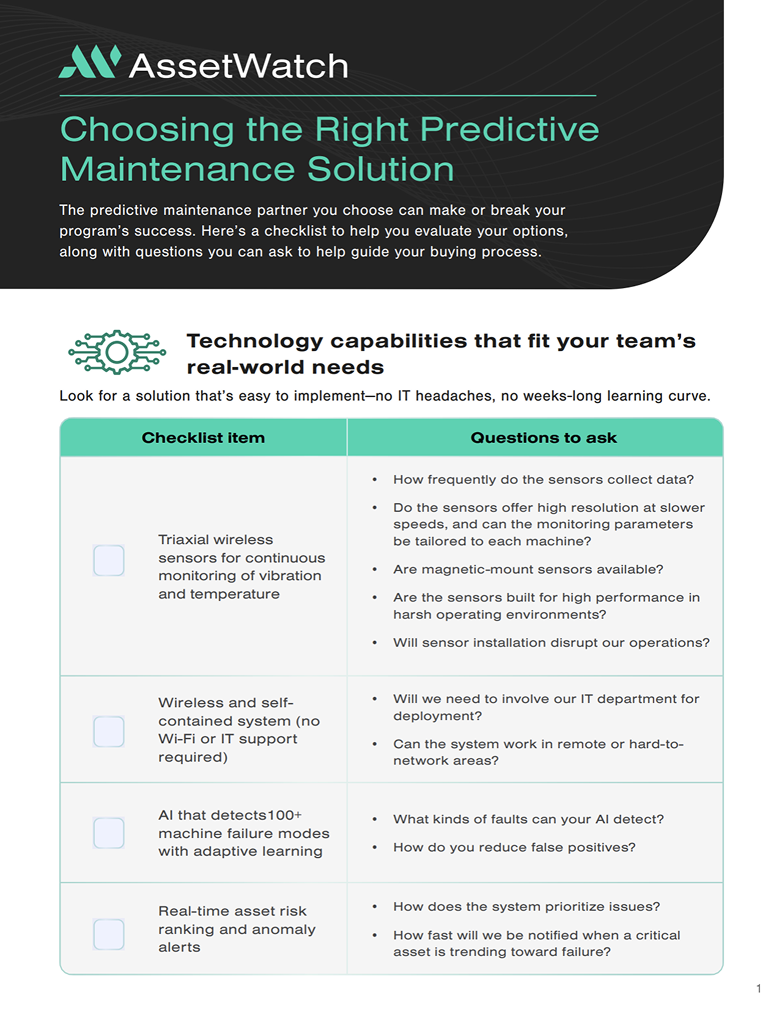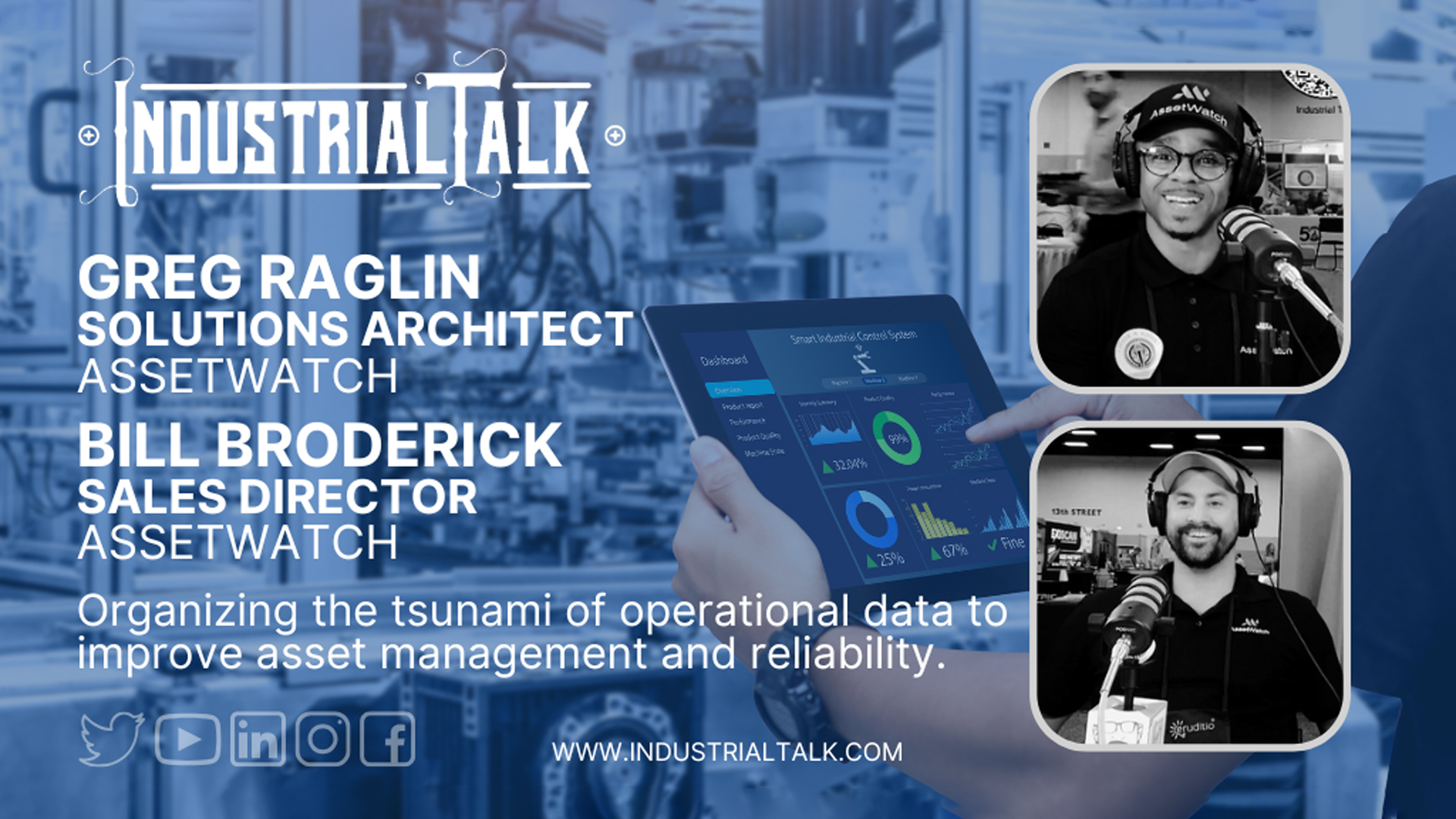Is it time to address the gap between your maintenance and reliability teams?
For many manufacturers, this gap makes it tough to drive progress. While both teams want the same outcome—safe, efficient, uninterrupted production—they might not be working toward that outcome in the same way. Maintenance teams are under pressure to keep equipment running, while reliability engineers are focused on longer-term improvements.
The good news is, there's a simple way to align your teams. With the right mix of maintenance approaches and tools, maintenance and reliability can work as one to maximize uptime and reliability, with decisions driven by real data and equipment failures prevented before they happen.
In this post, you’ll learn how condition monitoring bridges the divide, supporting reliability-centered maintenance and risk-based maintenance strategies so you can create the right maintenance plan for every asset—and finally get everyone on the same page.
Why maintenance vs. reliability shouldn’t be a competition
Maintenance and reliability teams have the same big-picture goal: keeping production running smoothly and safely. But their day-to-day priorities often pull them in different directions.
Maintenance teams are focused on scheduling maintenance, completing preventive maintenance, and responding quickly with corrective maintenance when things break. Reliability engineers are looking further ahead, studying failure modes, assessing the likelihood of failure and consequence of failure, and working to design strategies that reduce these risks over time.
It’s easy to see how this disconnect can lead to problems. Maintenance may rush repairs without addressing root causes, while reliability pushes for deeper analysis that slows things down. This can result in unnecessary maintenance that wastes time and money, reactive maintenance emergencies that stress teams and budgets, and higher risk of failure for critical assets.
To truly succeed, these teams need to move beyond a maintenance vs. reliability mindset and align around shared goals. That means adopting a unified approach built on real-world data, shared context, and common priorities.
Condition monitoring: the foundation for alignment
Condition monitoring provides the common language and single source of truth that both maintenance and reliability teams need. Instead of relying on fixed, time-based preventive maintenance schedules that might not reflect actual wear and tear, condition monitoring delivers continuous, real-time visibility into equipment condition.
Simplifying maintenance
As wireless triaxial sensors capture vibration and temperature data, AI detects and flag anomalies. Condition monitoring engineers (CMEs), working in partnership with the facility, filter out false positives and provide prescriptive recommendations to empower maintenance teams to spot early signs of potential failure and plan interventions exactly when needed. This process is designed to quickly reduce and ultimately phase out emergency maintenance surprises and unnecessary maintenance tasks.
Fueling reliability gains
Reliability engineers, in turn, gain evidence-based insights to perform failure modes analysis, conduct risk assessments, and identify critical assets that need extra attention. They can see exactly how and when a piece of equipment degrades, making their recommendations more precise and harder to dismiss.
By grounding decisions in real operating conditions, condition monitoring breaks down silos and helps both teams align on the right maintenance approach for every asset.
What is reliability centered maintenance, and how does it work?
Reliability centered maintenance (RCM) is a structured process designed to determine the most effective maintenance strategy for each asset. It doesn’t assume that every machine needs the same treatment. Instead, it asks targeted questions:
- What are the asset’s required functions?
- How can it fail?
- What are the consequences of failure?
- What maintenance approach is most effective at preventing those failures?
Condition monitoring strengthens RCM by replacing theory with data. Instead of guessing at failure modes or relying on generic schedules, teams can observe real-world trends. For example, vibration monitoring can detect the earliest stages of bearing wear, allowing teams to intervene before damage spreads. Oil analysis can highlight contamination or wear metals long before a machine seizes up.
This evidence-based approach enables maintenance teams to avoid both unnecessary maintenance and catastrophic failures. Strategies are tailored to the operational context, reducing the risk of failure while controlling costs.
In short, condition monitoring turns RCM from a paper exercise into a living, dynamic system that evolves with your plant’s needs.
What is risk based maintenance, and how does it work?
Risk based maintenance (RBM) focuses on prioritizing maintenance work where it will reduce risk the most. It asks:
- What’s the likelihood of failure?
- What’s the consequence of failure?
Assets that are critical to production or safety (Tier 1) get more attention. Lower-risk equipment (Tiers 2 and 3) might warrant route-based monitoring, lighter-touch preventive maintenance, or even a run-to-failure approach.
Condition monitoring is essential for this strategy to succeed. Without reliable data, risk assessments are guesswork. Condition monitoring shows which assets are deteriorating, highlights where potential failure modes are developing, and quantifies the impact of potential failures in real time.
This allows teams to prioritize critical assets, allocate maintenance resources wisely, and reduce the risk of failure where it matters most. It also gives managers the confidence to extend maintenance intervals for low-risk assets without compromising safety or reliability.
Implement RCM and RBM with a condition monitoring foundation
Transitioning to a condition-driven approach doesn’t happen overnight, but the steps are clear and achievable.
- Perform a criticality assessment—Use both historical data and real-time condition monitoring. This helps identify the most critical assets based on their role in production, their failure history, and the consequence of failure. Your condition monitoring solution provider can walk you through this process and provide recommendations based on your plant needs, operating conditions, and all other relevant factors.
- Analyze failure modes—Condition monitoring provides the real-world evidence needed to understand how equipment actually fails. Teams can use this to inform failure modes and effects analysis (FMEA), moving beyond theoretical risks to actual failure patterns observed in your plant.
- Prioritize maintenance activities based on risk—Allocate resources where they’ll reduce the risk of failure the most. For some assets, preventive maintenance on a schedule might still be appropriate. For others, condition-based maintenance or predictive maintenance may be better suited.
- Don’t forget the importance of integration—Modern systems can connect condition monitoring data directly to your CMMS, automatically generating and prioritizing maintenance tasks based on real equipment conditions. This eliminates manual guesswork and ensures maintenance management is aligned with operational needs.
- Train your team—Even the best data is useless without the expertise to interpret it. Make sure both maintenance and reliability teams understand the value of condition monitoring techniques and can use them to make smarter decisions. A condition monitoring engineer (CME) dedicated to your facility can help onboard your team and provide ongoing support from day one.
Create a culture of shared responsibility
For condition monitoring, RCM, and RBM to deliver their full value, you need a culture where maintenance and reliability see themselves as partners, not competitors.
This means recognizing that unnecessary maintenance and reactive maintenance are opportunities for much-needed improvement. It means encouraging teams to share data, discuss priorities openly, and agree on the right maintenance for each asset based on operational context and risk of failure.
Long-term success also requires leadership support. Investing in condition monitoring systems with AI and human experts working together to optimize maintenance and improve reliability translates to safer, more reliable, and more cost-effective operations. As you prove the value of your program across the organization, you can build momentum culturally, scale easily, and compound your ROI over time.
To move away from reactive maintenance, you need buy-in from leadership and facility teams. Getting there is easy if you're focused on the right metrics. To calculate the value of wireless sensors, predictive analytics, and dedicated human experts—all included in a full-service condition monitoring solution—download the KPI checklist today.
Bring it all together
There's no room for maintenance vs. reliability battles in modern manufacturing, and there's no need. Condition monitoring offers a shared foundation where both teams can access real-time data on asset health, align on priorities, and make better decisions together.
- Reliability-centered maintenance (RCM) uses this data to identify failure modes and choose the right maintenance approach for each asset.
- Risk-based maintenance (RBM) uses the same data to focus resources where they reduce risk the most.
- Together, RCM and RBM help facilities avoid unplanned corrective maintenance, reduce maintenance costs, and extend equipment life.
By uniting maintenance and reliability around condition-based maintenance and predictive maintenance strategies, your teams can shift from reactive firefighting to a proactive, planned approach that maximizes uptime and protects critical assets.
Ready to jump-start collabration and progress at your plant?
If you want to take charge of your condition monitoring data, align your teams, and empower them to win—while simplifying and optimizing your maintenance program—check out this free webinar: “Chaos-Free Condition Monitoring: A Proactive Approach to Maintenance.” Watch the replay here.

















